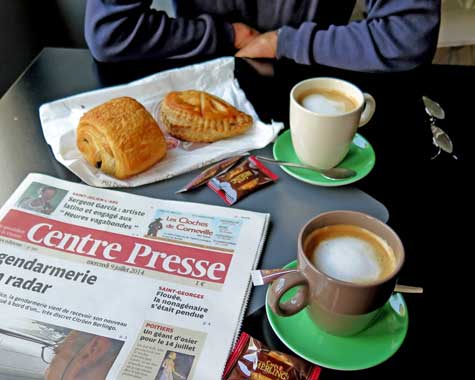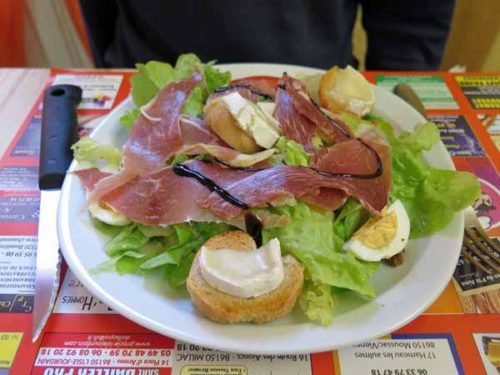
Wednesday, 9 July 2014
Distance 17 km
Duration 3 hours 40 minutes
Ascent 270 m, descent 261 m
Maps 139 and 146 of the TOP100 lime-green series
We woke at 7 am, later than usual, but we did not have far to go and we had made up our mind to repeat the wisdom of yesterday and visit the bar in the village before setting off.
Leaving the tent up and our gear half-packed, we traipsed over the bridge yet again. The water was glassy and the clouds high and distant this morning.
At the boulangerie we bought a chausson and a pain au chocolat and took them to the hotel bar across the road, where the same quiet woman was in attendance to make coffee for us.

There were a few other drinkers, including a man who had just delivered a tray of eggs to the boulangerie and another to the bar.
As we sat there in the warm, pleasant room, the door opened and our host and hostess from last night stepped in. Céline came over and gave us each two kisses, to the astonishment of the barwoman, and Lionel shook our hands. They sat down with the egg man, who no doubt provided their eggs as well.
Although we knew that we would never see each other again, we parted with warm affection. On our side it was because of her praise of my French, and on their side because of our praise of their restaurant, and probably our solidarity with them against their boorish English customers.

We crossed the river, collected our possessions and set off happily along the forested river road, which was one of those tarred lanes devoid of traffic so beloved by walkers. However, I had accidentally packed the map away, with the result that at the first fork in the road, we did not know which way to turn.
While I was scrabbling in my pack, the shutters of a house opened and a woman poked her head out. I said that we were looking for the way to the barrage of Jousseau, at which she pointed to the left and said, “C’est là, la bonne route”, with a sympathetic smile which seemed to say “Sooner you than me!”.

The next section clung to the river bank and we saw signs for the “Chemin d’Oc et Oil”, part of a newly developed set of paths in the vicinity. (The name reflects the position of Availles-Limouzine on the old linguistic divide between south and north, where the words for “yes” were respectively “oc” and “oil”).

The barrage itself was a little hydro-electric scheme, holding back a vast sheet of water.
At this point we rejoined the GR48 which we had left yesterday, and soon climbed away from the river on a muddy, rutted wheel track.
After a while we emerged from the forest at a farm high above the surrounding land, with various barns and sheds as well as the main house, and tracks going off at all angles.

As we were searching for a GR mark, we were surprised by a party of exhausted boy scouts appearing from one side.
They had just struggled up from the river and their leader knew as little as we did, or possibly less, about the area, so he was worried that we were trespassing, but I said not to worry, as it was a GR.
We left them to their own devices and set off on a track which seemed to be heading the right way, but had to follow it for quite a distance before we saw a GR sign.

Eventually we arrived in the back streets of the picturesque perched village of Millac.
Here everything was spick and span, with trim red-roofed houses, flower beds, painted shutters and a lovely old church jutting out into the roadway. However there was no hint of a bar or indeed of any commercial activity, which detracted greatly from its charm in our eyes.
We had given up hope when Keith happened to see a small circular Kronenborg sign hanging from a wall in the side street. To our great delight, this proved to be a multi-service shop, with a supermarket at the front and a bar at the back.

It was an old stone house that had been transformed recently in the most attractive way. We sat with our backs against the wall, chatting with the other customers – local housewives and some passing motorcyclists – who occupied stools at the counter.
The coffee was delicious and our little dumpling of a hostess brought us two cup cakes that she had made that morning, as a gift of friendship from France to Australia, she said.

We stepped out reluctantly from this haven and continued down the road for a while until the GR wandered off through fields of young sunflowers, and later through a tangled wood that threatened to close in around us.
We were reminded of yesterday’s battle with the blackberries, but it did not come to that, because we emerged onto a road just as things were getting unpleasant.
By then we were on the edge of the river and almost in the town of L’Isle-Jourdain. We passed the bridge of Saint-Sylvain (now the D10), a crossing point that had been in use since at least the eleventh century. It was the old link between Poitiers and the county of la Marche, which was more or less equivalent to the modern department of the Creuse.
Although we did not see it, there is a little island jutting off from this bridge, the site of an ancient fortress controlling the passing traffic. It was built by a lord called Jourdain, hence the name of the town, or so we were told.

At one end of the bridge stood a statue of Saint Sylvain.
The story was that he had been martyred and his body thrown into the Vienne, subsequently washing up at this point, which became a minor pilgrim destination in an age when pilgrimage was almost a form of tourism.
Instead of turning up towards the centre of town, we followed the signs to the camping ground, which was past the enormously high railway bridge, past the swimming pool and past the sports field.

It was a tiny place cloaked in trees and sloping abruptly down to the river.
The office was closed but there were tents and caravans scattered about, plus a row of little tents with one large marquee – possibly the encampment of the scouts that we had met earlier.
Not wanting to go down too far, we set ourselves up in a hedged plot near the entrance, high above the shower block.
After we had washed ourselves and our clothes it seemed too late for lunch, so we just sat about reading on some plastic chairs that we borrowed from outside the office. A couple of times we had to retire into the tent while a shower of rain passed.
A bus arrived and deposited the children at their tents, whereupon the place was filled with tumbling, running kids and joyful shrieks. They did not look like the scouts we had seen before, but maybe they were not as tired now.

Just as we were leaving, a man came and took our €7, then told us the quick way to town.
Nevertheless we managed to get lost, and had to zig-zag our way back to the main square, which was a pleasant sight with its war memorial bordered by flower beds and seats, and further out by shops, including two cafés.

One, the Hotel de la Paix, looked run-down, so we chose the other, called “Le 10”, and went inside, as it was too cold for the terrace.
It was a treat to be sitting in this warm, comfortable, convivial room with our glasses of rosé, which were large and filled to the brim.

As it was only 6:30 pm when we emerged, we had time to explore the town before dinner. We walked to the former railway viaduct, now a pedestrian and cycling path, to admire the view.
It was like the view from a hot-air balloon and it was no surprise to learn that they do bungee jumping here. The very thought made me shrink back from the parapet.
We could see the bridge of St-Sylvain, but only the edge of the little island going off from it. The rest was hidden by a bend of the river.

When we got back to the square it was after 8 pm, a respectable time to dine.
The choice was limited to the Hotel de la Paix or nothing (all the other restaurants were far away, closed in the evening, or having a day off).
Inside, the place was much better than we expected. There was even a flower-filled outdoor section but we preferred the warmth of the dining room, which was gracious in an old-fashioned, unpretentious way.
We gave our order but the waitress warned us that there would be a delay, as they were expecting a large party to arrive at the long table next to ours.

She brought drinks and some nuts to keep us going, and soon the guests trooped in – an English family of eleven, including two grandmothers, both with pink streaks in their hair (whether this was a case of rivalry or cooperation, we could not decide). The table filled with pizzas, soft drinks, beer and mountains of chips.
It is probably not the case that English speakers out of their own country talk more loudly than the locals; it may just be the fact that they are easier to understand that makes them so intrusive. Anyway, we got to find out more than we wanted to about this family.

Our dinner, when it came, was good plain French fare. The first course was a salad with hot goat’s cheese and boiled eggs, overlaid with sheets of lovely ham.
To follow I had chicken with green beans while Keith could not be turned from his habitual steak, with which he had chips, as he had had too many green beans in Aixe-sur-Vienne. The chips were the only point of correspondence between our dinner and that of our neighbours.
Back at the camping ground the kids were still dashing about merrily, but we were ready for sleep, even though it had been an easy day.
Previous day: Confolens to Availles-Limouzine